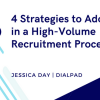There’s growing momentum for Artificial Intelligence (AI) across a variety of industries, ranging from financial services and healthcare to manufacturing and environmental initiatives. It’s no wonder, given the power of AI to find patterns in vast amounts of data faster than humans ever could and to predict outcomes and behaviors.
For example, banks and other organizations are using chatbots – AI programs that can mimic human conversation through speech or text – to address basic customer questions received at call centers or through customer support lines. These AI apps allow organizations to maintain 24/7 support and improve the customer experience by answering questions in real time, which would not be feasible or economical if they were staffed solely by humans. In another application, insurers can use AI apps to search claims for patterns that may indicate fraud, potentially saving a lot of man hours and money.
AI also is being applied in healthcare to predict which patients may return to a hospital after being released or which ones may not follow their drug protocols, so that providers can improve care and outcomes. On the environmental front, scientists are using AI to predict where forest fires might occur and to identify different species of mosquitoes so they can study the cause of pesticide resistance and help stop the spread of mosquito-borne diseases.
With all the insight, predictions and benefits that AI delivers across industries, it’s fast-becoming a critical tool in the technology toolset for all types of companies. But there are key roadblocks to adoption, beginning with the fact that many companies don’t have the internal expertise, resources or time to go it alone – and this where nearshoring is fulfilling a critical need. Consider the following:
- The shortage of data scientists makes talent hard to find
Creating AI programs requires specialized expertise that is hard to find. Data scientists design the algorithms that train the AI programs, and continually fine-tune them to increase accuracy. In order to learn, these algorithms require vast amounts of data, which data engineers aggregate, prepare and manage. However, there are not enough data scientists and engineers to go around, so many companies have to outsource their needs.Also, AI image recognition programs typically require crowds of people to identify images. While public data sets are available through solutions such as Amazon Mechanical Turk, private crowds are more effective in providing reliable, accurate data – and in a much faster timeframe – to help companies get better results. Creating and managing private crowds is a very time-consuming task that isn’t in the wheelhouse of most companies.
- Specialized computing power is expensive
More and more AI apps, especially in-depth learning programs that teach themselves, require powerful, advanced graphics processing unit (GPU) systems to crunch volumes of data quickly. The cost for these systems is another factor pushing organizations to turn to outsourcers.
- AI is an ongoing time sink
The very nature of AI requires ongoing work – it’s not a “one and done” process, but rather an iterative one. Smart apps are continually learning and need a constant supply of training data. Also, data scientists need to continually hone or change the algorithms so they perform better and more accurately. For example, if a chatbot has difficulty understanding and answering particular questions, the data scientist will update the algorithm to teach it this new information.
Nearshoring, an ideal option for AI development
Given the complexities of AI development and deployment, it’s no wonder that outsourcing is becoming the way many companies are fast-tracking their AI projects. Nearshorers in particular are benefiting the most. Working with a service provider that speaks the same language, has a shared culture and can easily collaborate is essential for any project, but more so with AI, which requires data scientists who can grasp a company’s specific business environment and all of its nuances. Just think about the use of a chatbot in customer service. It’s critical that a chatbot understand what a customer is saying – whether he/she is using slang words or not.
In addition, the proximity of nearshore firms allows them to easily spend time on site to get immersed in the customer’s business and be as available as needed. AI requires long-term partnerships and nearshore partners may be as close as you can get to in-house talent.
AI is fast becoming a business imperative for many organizations, enabling them to gain business insight, improve customer experience and predict outcomes. However, the shortage of highly skilled data scientists and the economic barriers to developing AI in house are fueling the impetus for organizations to outsource AI development. Nearshoring is a particularly attractive option because of the increased convenience, collaboration and communication that enables projects to be completed accurately, on time and on budget. That’s a competitive advantage that is invaluable in today’s marketplace.
Region:







